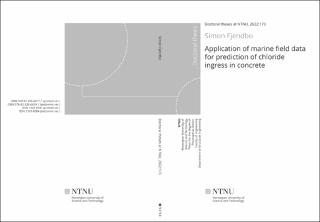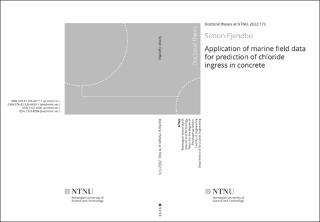| dc.contributor.advisor | Geiker, Mette | |
| dc.contributor.advisor | de Weerdt, Klaartje | |
| dc.contributor.advisor | Sørensen, Henrik Erndahl | |
| dc.contributor.author | Fjendbo, Simon | |
| dc.date.accessioned | 2022-07-13T15:33:27Z | |
| dc.date.available | 2022-07-13T15:33:27Z | |
| dc.date.issued | 2022 | |
| dc.identifier.isbn | 978-82-326-6659-1 | |
| dc.identifier.issn | 2703-8084 | |
| dc.identifier.uri | https://hdl.handle.net/11250/3005108 | |
| dc.description.abstract | A fixed link is about to be built across the Fehmarn Belt between Denmark and Germany. The main structure of the link is a submerged reinforced concrete tunnel with a design service life of 120 years considering corrosion initiation as limit state. With the aim of supporting the design and operation of the reinforced concrete structures for the fixed link, Femern A/S in 2010 established the Fehmarn Belt Exposure Site in Rødbyhavn, Denmark, where 15 concretes differing in binder composition are exposed.
Chloride-induced corrosion of embedded reinforcement steel is an important deterioration mechanism in marine exposed reinforced concrete structures. Concrete acts as a protective layer for the steel, both physically by impairing chloride ingress and chemically by passivating the steel due to the high pH of concrete. However, when a sufficiently high content of chlorides has penetrated through the concrete and reached the embedded steel reinforcement, steel corrosion is initiated. The focus of this study was to test and further develop the basis for application of chloride ingress models for service life design and reassessment of marine exposed reinforced concrete structures.
The topic was approached by conducting an evaluation of which chloride data to use and how to use them for chloride ingress predictions by analyzing a) microstructural changes in the concretes and their impact and b) the assumptions made if correcting for paste fraction. By comparing chloride profiles combined with petrographic analysis of tidal and submerged concrete after ten years of marine exposure, supplemented with moisture and portlandite profiles of the submerged exposed concrete and earlier data on microstructure and chloride ingress, the relationship between chloride profiles and microstructural changes was investigated. Because of stochastic variation in the paste fraction and systematic variations due to geometrical restraints at cast surfaces, data for total chloride content are occasionally calibrated using parallelly measured calcium content as a measure of the actual paste fraction assuming non-calcareous aggregates and no calcium leaching. The assumption of no calcium leaching was investigated by comparing calcium profiles measured after a half, two, five and ten years from the same concrete panels exposed at the Fehmarn Belt Exposure Site and by analyzing the impact of calibration on chloride profiles.
The earlier made square root observation of a linear relationship between the penetration depth of 0.05% chloride by wt. of concrete versus square root of time was generalized. The applicability and limitations were assessed, and the scope of validity widened with the aim of proposing it as a method (the square root method). Field data from marine submerged, tidal, splash, atmospheric and from inland deicing salt exposure at various Northern European locations was analyzed for a range of reference chloride contents. The square root method was compared to selected engineering models by evaluating the ability to predict data achieved after ten years of submerged exposure at the Fehmarn Belt Exposure Site based on data achieved up to five years of exposure. The tested models were (i) the fib Model Code, which include a time-dependent apparent diffusion coefficient (Da); (ii) the HETEK model, which include both time-dependent Da and surface chloride content (Cs) and (iii) the ClinConc model, which include time-dependent Da and indirectly time-dependent Cs (through time dependent chloride binding).
The results showed a microstructurally changed zone extending up to ten millimeters from the exposed surface was a general feature for all concretes exposed for ten years at the Fehmarn Belt Exposure Site. When comparing to previous results from the same panels, it was noted that the depth of the microstructurally changed zone progressed inwards over time. A correlation was observed between chloride profiles and microstructural changes. The depth of the maximum chloride content (xCmax) was found to almost coincide with the depth of the microscopically changed zone (xMCZ). A steady increase was observed in xCmax from 0.6-2.5 mm after six months to 4.5-10 mm after ten years and in xMCZ from 1-2.5 mm after six months to 4-10 mm after ten years depending on binder type with least progression for a concrete containing 67% ground granulated blast-furnace slag. Calcium calibration of chloride profiles is sometimes used to account for the higher paste fraction in the surface near region due to the wall effect and for stochastic variations in the paste content in concrete in general. However, calcium leaching can introduce errors to the calibrated chloride contents in the leached part of the profile. It was found that the calcium content in the surface near region (up to 10 mm) decreased systematically over the period of 10 years. This results in the calcium content no longer being a suitable measure of the paste fraction up to this depth. As a result of the decreasing calcium content to a depth typically extending beyond that of the maximum chloride content (“chloride peak”), it was found that the calibrated maximum chloride content in several cases was higher than the uncalibrated. Based on the findings, it is recommended to exclude datapoints from the microstructurally changed zone, i.e., the outermost datapoints including the maximum chloride content, when using field data for testing of chloride ingress prediction models, unless reactive transport models are used.
Analyses of chloride profiles with 237 combinations of concrete, exposure and reference contents showed that chloride ingress of a reference content followed a linear relationship with an average R2 of 0.96, when the penetration depth of the reference content was plotted against the square root of exposure time. This square root observation appeared valid for the studied Portland cement based concretes with fly ash, silica fume and ground granulated blast furnace slag exposed in submerged and tidal exposure zones, when applying reference contents of 0.1-1.8 % chloride by wt. of binder, and in atmospheric zone when applying reference contents of 0.1-0.5 % chloride by wt. of binder. It was found that the parameters describing the straight line depended on the chosen reference content. Faster ingress was seen for low compared to high contents. Further the slope of the straight line (ingress parameter) depended on the exposure with faster ingress for tidal than for submerged exposure. It was concluded that the square root method appears to be a promising method for reassessment of chloride ingress, among others because it does not rely on data affected by the microstructurally changed zone or calcium leaching. When comparing the square root method to other ingress models for reassessment, the square root method predicted with the lowest residual standard error (best), but currently it is only applicable for reassessment and not yet for design. | en_US |
| dc.publisher | NTNU | en_US |
| dc.relation.ispartofseries | Doctoral theses at NTNU;2022:173 | |
| dc.relation.haspart | Paper 1:
Fjendbo, Simon; Sørensen, Henrik E.; De Weerdt, Klaartje; Geiker, Mette Rica.
The square root method for chloride ingress prediction - Applicability and limitations. Materials and Structures 2021 ;Volum 54.
https://doi.org/10.1617/s11527-021-01643-8
This article is licensed under a Creative Commons Attribution 4.0 International License (CC BY 4.0) | |
| dc.relation.haspart | Paper 2:
Fjendbo, Simon; Sørensen, Henrik E.; De Weerdt, Klaartje; Jakobsen, Ulla Hjorth; Geiker, Mette Rica.
Correlating the development of chloride profiles and microstructural changes in
marine concrete up to ten years.
https://doi.org/10.1016/j.cemconcomp.2022.104590
This article is licensed under a Creative Commons Attribution 4.0 International License (CC BY 4.0) | |
| dc.relation.haspart | Paper 3:
Fjendbo, Simon; Sørensen, Henrik E.; De Weerdt, Klaartje; Geiker, Mette Rica.
Testing of chloride ingress models versus 10 years field data from the Fehmarn Belt marine exposure site | |
| dc.relation.haspart | Paper 4:
Fjendbo, Simon; Sørensen, Henrik E.; De Weerdt, Klaartje; Geiker, Mette Rica.
When and How Should Chloride Profiles be Calibrated for Paste Fraction?
Nordic Concrete Research Volume 66 (2022) - Issue 1 (July 2022)
https://doi.org/10.2478/ncr-2021-0021
This work is licensed under the Creative Commons Attribution-NonCommercial-NoDerivatives 3.0 License. (CC BY-NC-ND 3.0) | |
| dc.title | Application of marine field data for prediction of chloride ingress in concrete | en_US |
| dc.type | Doctoral thesis | en_US |

